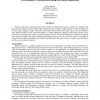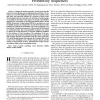1880 search results - page 46 / 376 » A Fact-Oriented Approach to Activity Modeling |
ECCV
2010
Springer
13 years 11 months ago
2010
Springer
Abstract. Much recent research in human activity recognition has focused on the problem of recognizing simple repetitive (walking, running, waving) and punctual actions (sitting up...
JECR
2000
13 years 7 months ago
2000
Software agents are a major innovation in how people use information systems, and they have parallels with how Decision Support Systems (DSS) support human decision-making. A DSS ...
TOOLS
2008
IEEE
14 years 2 months ago
2008
IEEE
Abstract. A popular approach to compositional verification of component-based applications is based on the assume-guarantee paradigm, where an assumption models behavior of an env...
TIP
2008
13 years 7 months ago
2008
Changes in motion properties of trajectories provide useful cues for modeling and recognizing human activities. We associate an event with significant changes that are localized in...
ISBI
2006
IEEE
14 years 8 months ago
2006
IEEE
Different approaches have been considered so far to cope with the temporal correlation of fMRI data for brain activity detection. However, it has been reported that modeling this ...


